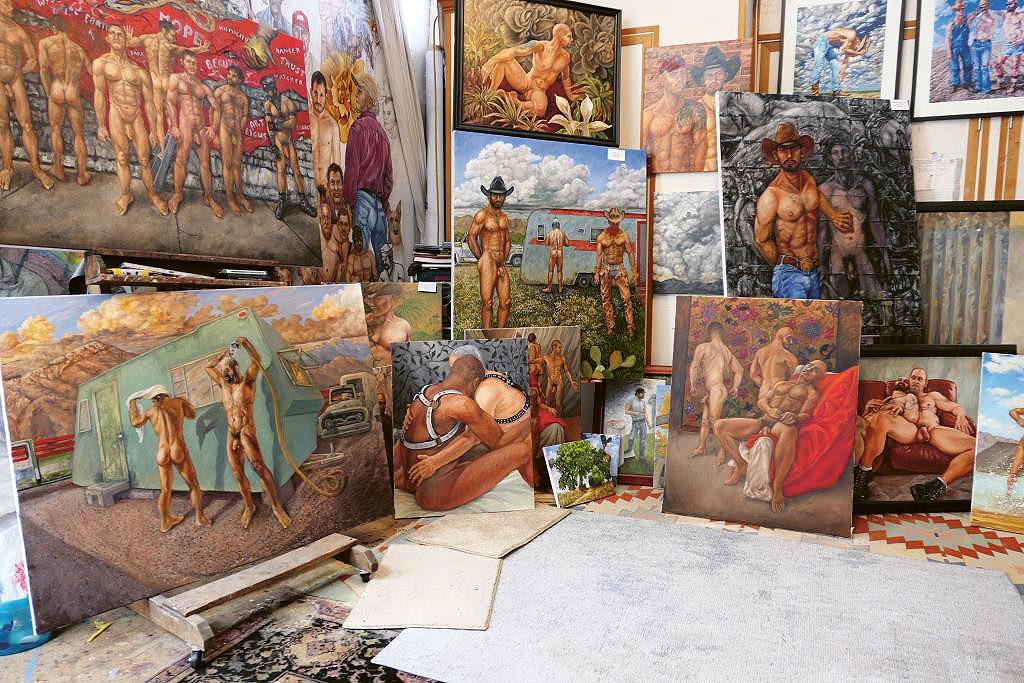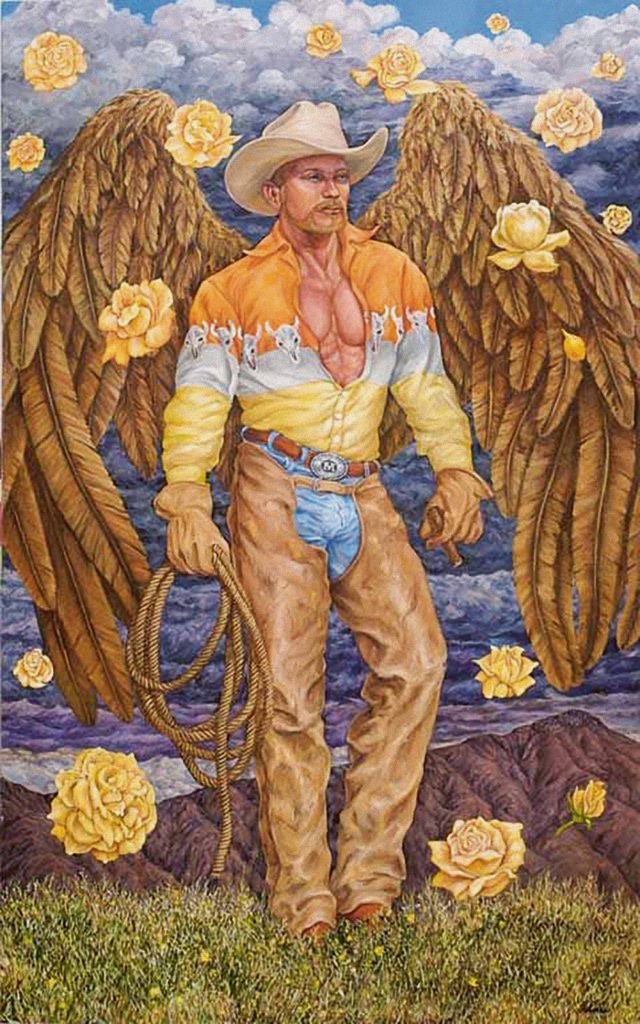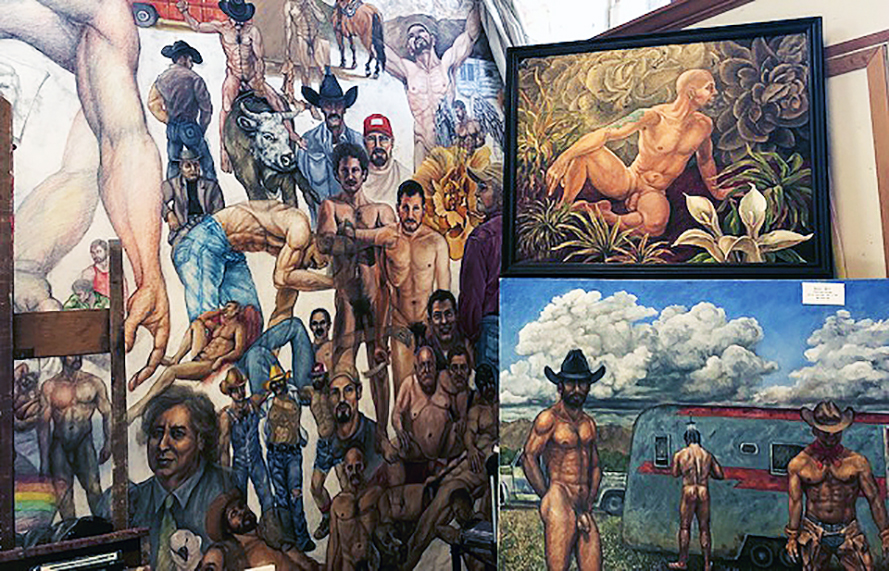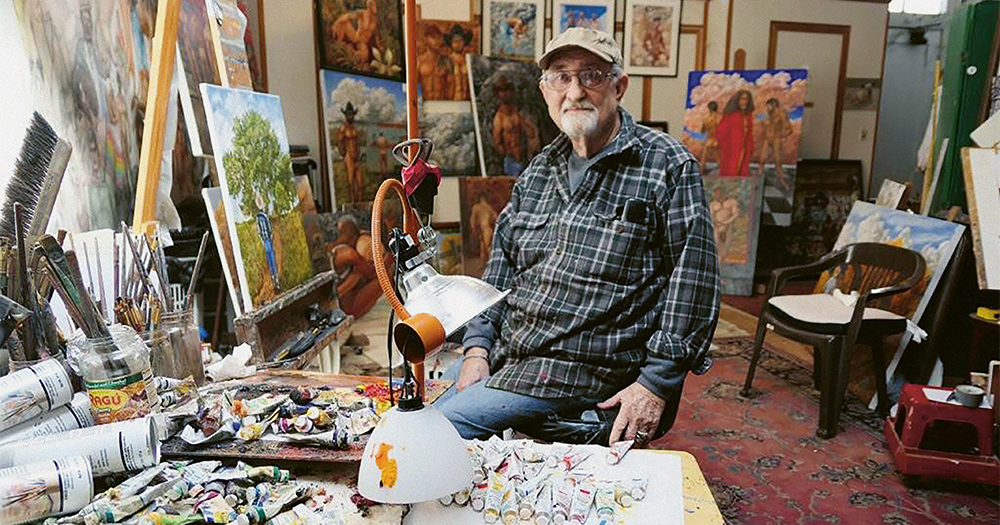Fi Connors and her partner, the ‘Brunette’ took a road trip across the US to visit the startlingly original artist Delmas Howe in his studio to find out just what inspires his unique genius. It would prove to be the perfect example of why you should meet your idols.
It’s a hot day setting out for Truth Or Consequences. Yes, you read that name right – we are on the road barreling towards this distant, oddly named town in New Mexico, our hair blowing in the wind. As a homage to AA Gills’ Blonde, my partner – the Brunette is sitting on the air conditioned seat beside me… with every window in the jeep down. She is way too excited, her eyes glued to the road, laughing off the ‘leaping deer’ road signs, driving ever so increasingly “gently” over the speed limit. We are late, and on our way to meet one of her art heroes for tea and a chat. Well, coffee and a chat.
This IS America after all. The desert has a strange feeling of being almost dream-like in the way sand meets sky. It is arresting, disorientating and profoundly calming all at once. As the hours pass we feel horizon-tipsy, then horizon-drunk. This trip to Truth Or
Consequences are not borne out of madness. And yes, before we even begin with the wonderment that is this interview, here are some quirky facts to do with this approaching location; This town changed its name from Hot Springs to Truth Or Consequences for a dare. On a Fool’s Day April 1 challenge, in the year 1950.
The horror master-writer Stephen King, who lives very far away in much cooler climes in Bangor, Maine, holds the key to this minuscule city (population 6,500-ish). Richard Branson owns a Virgin Galactic launch station somewhere between here and another few miles of yellow desert. He intends to start commercial flights into the close reaches of space in the near future. I feel relieved there are no official timelines as yet. I will start saving my pennies.
We rock up to Main Street, Truth Or Consequences with five minutes to spare. The Brunette is beside herself and is now speedily trying to pull herself together. She applies lip gloss and tousles her hair. She has been a fan of Delmas Howe since she was gifted a mural of his by her favourite aunt. Her fingertips have traced this mural every day for the last few years. She is now about to meet the living artist in the flesh. I smooth down my hair and try to become dignified and deserving of the title of ‘Irish Journalist’.
The main street is unassuming. A ribbon of tarmacadam lies baking in the sun, a few nondescript buildings holding each other up in the glare. We knock on the red door. Delmas Howe answers. The Brunette tries not to squeal. After the hello’s, and great we- made-it’s, Delmas Howe leads us gently inside to the vaulted cool of his studio.
And whoah. Heart stop. WHAT a studio. It is breathtaking. Male nudes on canvas stocked to the ceiling. An enormous wall mural of such incredible proportions, that I feel the Brunette’s knees buckle.
To fill you in, Delmas Howe was born here in 1935, he progressed to Wichita State University, majoring in music, after four years in the Air Force he moved to the East Coast, then graduate work at Yale University, followed by several years of classes in NYC at the Art Students League of New York. Delmas Howe is a trained classical concert bassoonist. After returning to the West, designing and holding a studio in Amarillo, Texas, he returned to Truth Or Consequences. His work is found in the collections of several museums, including the Albuquerque Museum where the painting, The Three Graces, hangs.
Delmas leans back in his chair as we begin.

Growing up?
“Well, there is a story – of course, art is full of story. I was born and raised here. I came back in the ’80s to look after my ageing folks. As you can imagine, growing up here in the 1930’s, ’40s and ’50s was not easy. It was during my period in the Air Force that I came out. It was a very different world back then, we didn’t even use the word ‘homosexual’.”
“My dad loved ranchers and cowboys. He would invite them in to party. I loved sitting on the laps of the cowboys, of course, I was only a child, I loved the smell, I still love that smell; the horse sweat and the leather and the tobacco and whisky. Of course, I didn’t know I was gay. I was a baby queer, but I didn’t know that. The only images of male nudes I could find were in the Encyclopedia Britannica. At some point, I combined the cowboy with mythology. The cowboy, of course, is one of our main mythological beings. The Three Graces was my first attempt to combine the two, and I went on from there.
“I started playing the piano very young. My mom encouraged it, but not my dad. He wanted me to be outside hoeing weeds, he wanted me to be a cowboy. So I suppose I was something of a disappointment to him. My Dad used to take me to roundups, I would cry the whole time. Brand the calves, dehorn, all sorts of barbaric stuff. If I had followed his advice, I would probably be an alcoholic cowboy, living in a trailer home with an unattractive wife and several kids.”
“I went to NY to study music and art and being gay (laughs). They had the best of everything there, even the best gays (chortles). I got a scholarship to Yale University, and while I was at Yale I realised I did not want to go on with my music career. So, I dropped out. And the ‘60s were a good time to do that! I had already dipped my toe into the decadence of New York City, and that was very appealing to me. I continued my studies at the Arts Student League. I have been painting as a professional artist since 1962.”

Did your sexuality have an influence on your art? Did art help your acceptance of your sexuality?
“I celebrated when I came out. I was engaged to a woman at the time, and of course, I knew something was missing. After I knew I was gay and moved to New York, I knew I wanted to draw the male figure. I do like men a lot. I love men. I really love men (laughs). My attention to anatomy is because of that fact. In the 1950’s the abstract expressionists had taken over the art scene in New York, and no one was interested in my realistic narrative paintings with a gay theme. Nonetheless, I persisted.
“For a long time I felt I was schizophrenic, I would walk down the street in New York and I would see a gallery and think, ‘I should paint like that’, and then I would cross the road and see another artist with another completely different style and I would think, ‘I should paint like that’. I spoke to my great friend Edward Lucie-Smith and he told me, ‘Go back to your roots’ and that’s how I ended up combining myth with the cowboy.”
What is your daily schedule when you are painting?
“The light is good from 8.15. It gets bad about midday when the sun is directly overhead. The afternoon it gets good again. I get a little more time. I have very little distractions. I don’t socialise very much. At this point in my life, chatting is not appealing to me. I listen to opera while I paint. My favourite composer is Verdi.”
What do you count as inspiration?
“I’m looking forward to my retrospective in October of next year. I’ll be 85. I am painting toward that.”

How difficult has it been to be an openly gay artist?
“I had friends who were supportive. That’s what I wanted to do and I am still doing it. I would have gone crazy if I had not focused on my passion.
“I lived two blocks from Stonewall. When I was first In NYC, you could be arrested for putting your arm around another man in public, even as a friendly gesture. We were harassed by the police all the time. Suddenly it was legal to be gay, and by then we just had enough. I did not realise that was the beginning of gay rights. There was immense tension. If you have a Puerto Rican drag queen angry at you, you know you better watch out (laughs).
It was a rollercoaster. First the celebration of gay rights, and then life became increasingly promiscuous. It was a political act on the part of gay people to have sex in public – the spas in New York, the spas in Dallas. We moved and travelled. One of my favourite spas in New York, I recognised everyone there from Dallas. And then the advent of AIDS. Nobody knew, nobody knew…”
What do you want to say to your GCN readers in Ireland?
“It is important to find out what you want to do. Sometimes that is very difficult, but once you find out, then you do it. Don’t let anyone discourage you. I had to decide whether to take a position in an orchestra and have that life. I just said ‘no, I just don’t want to do that’. It was a very conscious decision and a traumatic decision. I had made money playing the bassoon. With my decision, I was on the street with all the other artists. I eventually found my roots, and combined myth and the erotic…making men as attractive as possible. It’s been my life’s work.”
Delmas Howe ’s latest exhibition is in the Rio Bravo Fine Art Gallery.
Photos of Delmas were taken by Michael Winkler. For more of Michael’s work, visit www.michaelwinkler. com.au.
This story was originally published in GCN Issue 356.
© 2020 GCN (Gay Community News). All rights reserved.
Support GCN
GCN is a free, vital resource for Ireland’s LGBTQ+ community since 1988.
GCN is a trading name of National LGBT Federation CLG, a registered charity - Charity Number: 20034580.
GCN relies on the generous support of the community and allies to sustain the crucial work that we do. Producing GCN is costly, and, in an industry which has been hugely impacted by rising costs, we need your support to help sustain and grow this vital resource.
Supporting GCN for as little as €1.99 per month will help us continue our work as Ireland’s free, independent LGBTQ+ media.

comments. Please sign in to comment.